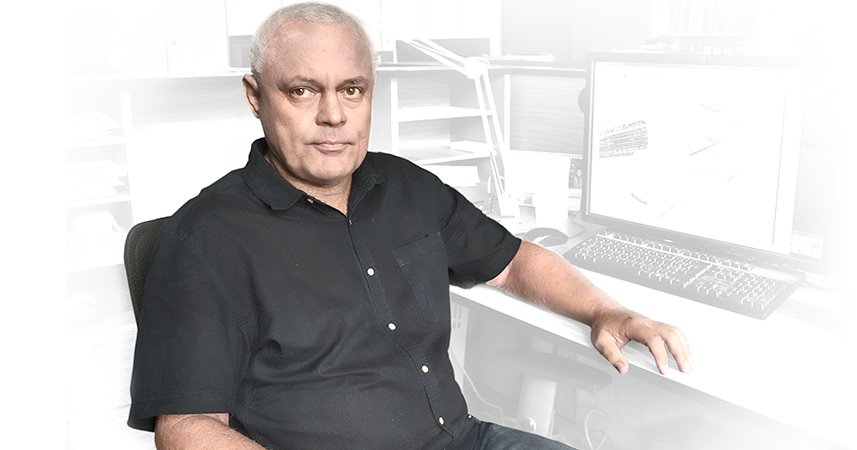Pavel is a Structural Computing Specialist, and his job is to make sure that our planes are as rigid as they should be. Joining Aero was a no-brainer to him, since he already worked with the company while in college. His career record includes a whole array of airplanes, from L-39 MS to the current L-39 NG and the Ae 270 project.

What position do you hold at Aero? What's your job description?
I work as a structural engineer at Aero. My job consists of performing computations concerning the airplane’s rigidity. That means tensile deformation states and their evaluation from the viewpoint of designed structures. When performing repairs, we put great care into making sure that we keep the required rigidity of the plane, while not compromising the lifespan of the structure, so the customer gets what they ordered.
As a standard, we use the method of end elements, which enables us to evaluate everything and design a solution. Then, we can demand changes from engineers, starting a process that ends with a useable part. The part goes straight into use, or, in case of more complicated units, goes through further processes, such as certification or testing. If that's development testing, it is often performed in our test lab. If it's a more difficult job, we prepare a specification for other subjects that work with us – typically VZLU or CTU. We offer a support to the tests and watch over methodology. Usually, we follow the most important points of the test and then perform an evaluation, which then has an impact on changes in engineering or development of the part in question.
What was your career path to Aero?
It was very simple, because I studied airplane structural engineering and design, which meant that since my 3rd year in college, I worked together with structural engineers at Aero. That was back when the L-39 MS jet trainer was being developed. I smoothly went from my diploma thesis and seminar works to working a full-time job. Between that, of course, I spent a year in military service, working once again around planes in České Budějovice. After coming back, I sat on a structural engineer's chair – the one I'm sitting on until this day.
What do you value the most about working for Aero? What do you enjoy?
I like getting paid :). However, it was always doing what I enjoyed. I graduated as structural engineer, who later learned to do structural computing. I have colleagues who went other way. So we are a combination of applied physics, from one side or another. I'm lucky that I can do what I love and that I could continue with what I studied and apply it to the real world, from the L-39 MS project to the L-159. That way, I could take part in the smooth development process that continues to this day. In between, Aero started developing its own projects, which gave me an opportunity to be included in the development of the re-engined version of the L-39. The prototype we built then is still flying. In the meantime, Aero started working on the Ae-270 project, developed in cooperation with Aircraft Industries. In that period, we have also worked on L-159 development, and then there were programmes for Sonaca. We also had an opportunity to cooperate on EFB with a Swedish company. We worked on support of their devices' installation into civil planes, which means that we have STC for basically all the Airbuses from 300 to 340, as well as Boeing 747 or two Embraer types. This enabled me to „go through“ many different airplanes, which is an interesting experience for an engineer.
What do you work on now?
At this moment, it is the L-39 NG project that requires our most intensive effort. The first phase was re-engining the old L-39 airframes for the Williams engine. For me, it meant taking part in developing tests and parallel running applications or application modifications that we have on the 23-26 airplane. And of course, we are still developing the wing for this new model. At the same time, we are working on the flyable military airframest, preparing support for later repairs, be it PP2000 or PP4000. And then there's the never-ending work on further upgrades and development of current planes, be it old L-39s at operators all around the world or support for Czech Army.
How does cooperation between different teams work?
I wouldn't call it cooperation, I would say it's living together. Cooperation means that you agree on something, you work on something individually and then meet again. It doesn't work that way. We are in daily contact, still solving various problems and interacting together. The advantage is that compared to, say, engineering, there's comparatively few of us. We are concentrated into two floors, mostly construction and analysis, a part of technology and test room.
What would you recommend to applicants who would like to work at Aero, or specifically at the structural computing department?
The most important is the drive to do this. The best scenario is if such a person finds what he or she likes during his studies. Aero regularly offers lectures and presentations at schools, supplementing our teaching with practical experience. So we are usually in contact with students. We also support them working on diploma thesis. We work on topics that interest us and that would fit in our development activities. At this moment, we have two students like that. Right now, I'm writing a peer review for a thesis for one of them. These are the adepts we hand-pick and the ones who we offer a job after school. If they’re not only talented, but also fit our team personally, there's nothing to hesitate about.